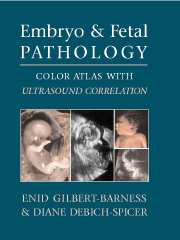Book contents
- Frontmatter
- Contents
- Foreword by John M. Opitz
- Preface
- Acknowledgments
- 1 The Human Embryo and Embryonic Growth Disorganization
- 2 Late Fetal Death, Stillbirth, and Neonatal Death
- 3 Fetal Autopsy
- 4 Ultrasound of Embryo and Fetus: General Principles
- 5 Abnormalities of Placenta
- 6 Chromosomal Abnormalities in the Embryo and Fetus
- 7 Terminology of Errors of Morphogenesis
- 8 Malformation Syndromes
- 9 Dysplasias
- 10 Disruptions and Amnion Rupture Sequence
- 11 Intrauterine Growth Retardation
- 12 Fetal Hydrops and Cystic Hygroma
- 13 Central Nervous System Defects
- 14 Craniofacial Defects
- 15 Skeletal Abnormalities
- 16 Cardiovascular System Defects
- 17 Respiratory System
- 18 Gastrointestinal Tract and Liver
- 19 Genito-Urinary System
- 20 Congenital Tumors
- 21 Fetal and Neonatal Skin Disorders
- 22 Intrauterine Infection
- 23 Multiple Gestations and Conjoined Twins
- 24 Metabolic Diseases
- Appendices
- Index
7 - Terminology of Errors of Morphogenesis
Published online by Cambridge University Press: 23 February 2010
- Frontmatter
- Contents
- Foreword by John M. Opitz
- Preface
- Acknowledgments
- 1 The Human Embryo and Embryonic Growth Disorganization
- 2 Late Fetal Death, Stillbirth, and Neonatal Death
- 3 Fetal Autopsy
- 4 Ultrasound of Embryo and Fetus: General Principles
- 5 Abnormalities of Placenta
- 6 Chromosomal Abnormalities in the Embryo and Fetus
- 7 Terminology of Errors of Morphogenesis
- 8 Malformation Syndromes
- 9 Dysplasias
- 10 Disruptions and Amnion Rupture Sequence
- 11 Intrauterine Growth Retardation
- 12 Fetal Hydrops and Cystic Hygroma
- 13 Central Nervous System Defects
- 14 Craniofacial Defects
- 15 Skeletal Abnormalities
- 16 Cardiovascular System Defects
- 17 Respiratory System
- 18 Gastrointestinal Tract and Liver
- 19 Genito-Urinary System
- 20 Congenital Tumors
- 21 Fetal and Neonatal Skin Disorders
- 22 Intrauterine Infection
- 23 Multiple Gestations and Conjoined Twins
- 24 Metabolic Diseases
- Appendices
- Index
Summary
MALFORMATION
A malformation is a qualitative, structural end result of a disturbance of embryogenesis leading to a (congenital) defect of an organ, body part, or body region. Such defects can be mild or severe, common or rare. They arise either during blastogenesis (first 4 weeks of development) or during organogenesis (2nd half of embryogenesis, weeks 5-8). Defects of blastogenesis tend to be severe, to be frequently lethal, and to involve several parts of the developing organism sharing a common inductive molecular pathway (polytopic anomalies; i.e., DiGeorge anomaly) (Figure 7.1 and Tables 7.1 to 7.5). Defects of organogenesis tend to involve single structures (monotopic anomalies) – i.e., isolated polydactly, cleft palate, distal hypospadias, etc. Regardless of how mild or common in the population, malformations are never normal. Mild malformations (cleft uvula or xiphisternum, agenesis of palmaris longus muscle or of upper lateral incisors, spina bifida occulta of L5) are common in the population and tend to be dominantly inherited.
Developmental Fields
Developmental (or embryogenic or morphogenetic) fields are the parts of the embryo that react as a unit in response to normal inductive, teratogenic, or mutational causes (Tables 7.6 and 7.7). During early blastogenesis the entire pluripotent embryo is the primary field. A midline, axis formation and the initial events of gastrulation are its most important morphogenetic characteristics. Progenitor fields (Davidson) arise in the primary field and represent upstream expression domains of combinations of molecular inductive systems including transcription factors (e.g., HOX, SOX, TBX genes), growth factors (FGF, BMPs), and secreted morphogens (i.e., SHH).
- Type
- Chapter
- Information
- Embryo and Fetal PathologyColor Atlas with Ultrasound Correlation, pp. 207 - 226Publisher: Cambridge University PressPrint publication year: 2004



